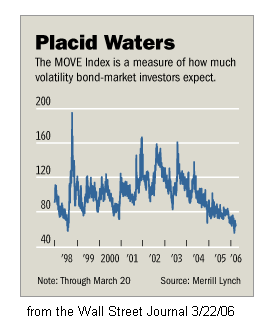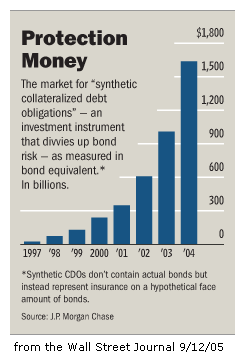

|
| weblog/wEssays archives | home | |
|
Complacency, Denial and Risk (April 11, 2006)  Even as global stock markets hit multi-year highs, and bond markets bask in historically
low rates, the global economy rests precariously on three wobbly legs: oil, derivatives and
real estate. If any one of these crumbles, the global economy will crumble with it.
As these charts will reveal, the odds of all three crumbling are rising dramatically.
Even as global stock markets hit multi-year highs, and bond markets bask in historically
low rates, the global economy rests precariously on three wobbly legs: oil, derivatives and
real estate. If any one of these crumbles, the global economy will crumble with it.
As these charts will reveal, the odds of all three crumbling are rising dramatically.
As this chart illustrates, investors are supremely confident that the risks of financial conflagration are low. What this chart is saying is that investors are so sure bond yields will stay low 10, 20 and even 30 years out that they're demanding virtually no risk premium. This is another way of saying that no one expects inflation to be an issue, because if they did, they'd demand a higher yield on long-term bonds as "protection" against inflation eating away the value of their bond. Yet the long bond and short bond yields are virtually identical--the infamous "yield inversion" which is a harbinger of recession. Not everyone is so complacent, of course; check My Biggest Worry: The Bond Market: by analyst Gary Kaltbaum: There is no doubt the "market" has been acting just fine...but corrections start because of investor's conditioned sense that nothing can go wrong. We have news for them, corrections do occur.  The unprecedented rise of exotic financial derivatives adds a highly unpredictable and
volatile risk into the global mix. As the Wall Street Journal summarized:
History Says a Financial Calamity Follows Rate-Lifting Campaigns; So Far, So Good
The unprecedented rise of exotic financial derivatives adds a highly unpredictable and
volatile risk into the global mix. As the Wall Street Journal summarized:
History Says a Financial Calamity Follows Rate-Lifting Campaigns; So Far, So Good
Global investors threw a record $262 billion at private-equity funds last year, small-cap stock indexes are at all-time highs, and colleague Scott Patterson recently reported that more than $20 billion has flowed into emerging-market stock funds so far this year, matching the total inflow for 2005 and roughly five times the amount of money pumped into emerging-market funds in 2004, according to the research firm Emerging Portfolio Fund Research.That the wheels are coming off the housing market/bubble is beyond debate. For a report from the front lines-- Florida--read this: The dreaded "D" word surfaces from Mish's Global Economic Trend Analysis. Tomorrow: why we can safely predict $80 a barrel oil. For more on this subject and a wide array of other topics, please visit my weblog. copyright © 2006 Charles Hugh Smith. All rights reserved in all media. I would be honored if you linked this wEssay to your site, or printed a copy for your own use. |
||
| weblog/wEssays | home |